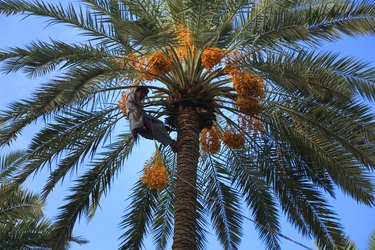
Pygmy date palms (Phoenix roebelenii) are ornamental palm trees that mature to a height of 6 to 12 feet. These trees are commonly grown in sub-tropical and tropical locations of U.S. Department of Agriculture plant hardiness zones 10 and 11 as specimen trees. Not only is this tree ornamental, but it also produces a delicious fruit. While generally healthy, this type of palm tree is susceptible to some diseases.
Leaf Spot Fungus
Video of the Day
Leaf spot is a fungal disease that damages the fronds of robellini palms. There are a variety of pathogens that can cause this disease but all of them result in the same symptoms. As this fungal disease infects the palm, water-soaked lesions will start to appear on the palm fronds. As these lesions progress, they will turn yellow, gray, reddish-brown, brown, or black in color.
Video of the Day
The longer the tree is infected, the more numerous the lesions. Left untreated, this disease will kill the palm fronds. Fungal spores will spread to other leaves of the tree, causing the deterioration of the foliage. Fortunately, leaf spot can be treated with the use of fungicides, which should be applied per manufacturer instruction.
Bud Rot Disease
Bud rot is a disease that commonly damages robellini palm trees. This disease is most prevalent in younger trees located in sub-tropical and tropical locations worldwide. This disease can be caused by different pathogens, notably Phytophthora and Thielaviopsis.
The bud (meristem) of the palm is the point from which the tree grows. Essentially the "heart" of the plant, young buds can become infected with bud rot, causing them to become damaged and prohibiting them from absorbing the nutrients from the soil that are necessary to thrive.
As this disease progresses, the roots and stem show signs of damage, no new leaves emerge, and the plant can eventually die. Phytophthora and Thielaviopsis are both spread through fungal spores and may be treated with fungicides, although these treatments are best applied as a preventive measure instead of a curative. Apply all fungicides per manufacturer instruction. Copper-based fungicides are effective in treating bacterial bud rot.
Pestalotiopsis Fungal Disease
Pestalotiopsis and Pestalotia are pathogens that cause a disease, which damages many robellini palm trees. These fungal diseases will cause the tree to develop leaf spots, blights, and bud rot problems, depending upon the severity of the infection. Symptoms of this disease first appear on the leaves of the Pygmy date palm tree. Infected leaves will display small spots that are yellow, brown, or black in color.
As the fungus that causes this disease spreads and the disease progresses, the spots on the leaves will become larger and may feature a black outline around the perimeter. If only leaf spots are present, the prolonged health of the palm has not yet been compromised. In more severe infections, rachis blight or petiole blight may be present. At this stage in the infection, the tissue of the leaves has been compromised and the disease can easily spread down to the bud of the palm, compromising the healthy growth rate of a pygmy date palm or even endangering its life.
Pestalotiopsis is spread by spores created by the fungi. These spores can spread by air or irrigation to other parts of the same palm or to neighboring palm trees. To manage this disease, prune away any damaged leaves, sterilizing shears after every cut. The application of fungicides, used according to label directions, has also proven effective in treating this palm.